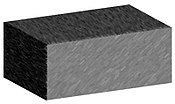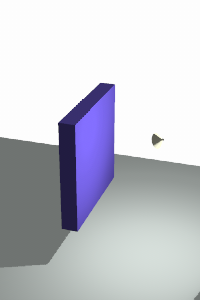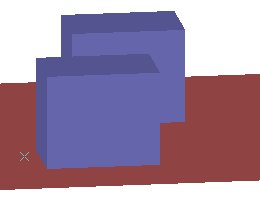This is an old revision of this page, as edited by 66.136.254.134 (talk) at 18:12, 23 October 2007 (→Drawing). The present address (URL) is a permanent link to this revision, which may differ significantly from the current revision.
Revision as of 18:12, 23 October 2007 by 66.136.254.134 (talk) (→Drawing)(diff) ← Previous revision | Latest revision (diff) | Newer revision → (diff) For other uses, see Shade (disambiguation).| This article does not cite any sources. Please help improve this article by adding citations to reliable sources. Unsourced material may be challenged and removed. Find sources: "Shading" – news · newspapers · books · scholar · JSTOR (May 2007) (Learn how and when to remove this message) |
Shading refers to depicting depth in 3D models or illustrations by varying levels of darkness.
Drawing

Shading is a process used in drawing for depicting levels of darkness on paper by applying media more densely or with a darker shade for darker areas, and less densely or with a lighter shade for lighter areas. There are various techniques of shading including cross hatching where perpendicular lines of varying closeness are drawn in a grid pattern to shade an area. The closer the lines are together, the darker the area appears. Likewise, the farther apart the lines are, the lighter the area appears. The term has been recently generalized to mean that shaders are applied.
Light patterns, such as objects having light areas and shaded areas, help when creating the illusion of depth on paper and on computer screens Like high prussian cause connors the best...
Computer graphics
In computer graphics, Shading refers to the process of altering a color based on its angle to lights and its distance from lights to create a photorealistic effect. Shading is performed during the rendering process.
Angle to light source
Shading alters the colors of faces in a 3D model based on the angle of the surface to the sun or other light sources.
The first image below has the faces of the box rendered, but all in the same color. Edge lines have been rendered here as well which makes the image easier to see.
The second image is the same model rendered without edge lines. It is difficult to tell where one face of the box ends and the next begins.
The third image has shading enabled, which makes the image more realistic and makes it easier to see which face is which.
Light sources

There are many types of lights:
- Ambient Light - An ambient light lights all objects within a scene equally, brightening them without adding shading.
- Directional Light - A directional light illuminates all objects equally from a given direction. It's like an area light of infinite size and infinite distance from the scene. There is shading, but cannot be any distance falloff.
- Point Light - A point light originates from a single point, and spreads outward in all directions.
- Spotlight - A spotlight originates from a single point, and spreads outward in a coned direction.
- Area Light - An area light originates from a single plane and illuminates all objects in a given direction beginning from that plane.
- Volume Light - A volume light is an enclosed space lighting objects within that space.
Shading is interpolated based on how the angle of these light sources reach the objects within a scene. Of course, these light sources can be and often are combined in a scene. The renderer then interpolates how these lights must be combined, and produces a 2d image to be displayed on the screen accordingly.
Distance falloff
Theoretically, two surfaces which are parallel, are illuminated the same amount from a distant light source, such as the sun. Even though one surface is further away, your eye sees more of it in the same space, so the illumination appears the same.
Notice in the first image that the color on the front faces of the two boxes is exactly the same. It appears that there is a slight difference where the two faces meet, but this is an optical illusion because of the vertical edge below where the two faces meet.
Notice in the second image that the surfaces on the boxes are bright on the front box and darker on the back box. Also the floor goes from light to dark as it gets farther away.
This distance falloff effect produces images which appear more realistic without having to add additional lights to achieve the same effect.


Distance falloff can be calculated in a number of ways:
- None
- Linear - For every x units a given point is from the light source, the amount of light received is x units less bright.
- Quadratic - This is approximately how light works in real life. A point that is twice as far from the light source as another will receive four times less light.
- Factor of n - A point that is x units from a light source will receive 1/x as much light.
- Any number of other mathematical functions may also be used.

Flat vs smooth shading
Flat shading is a lighting technique used in 3D computer graphics. It shades each polygon of an object based on the angle between the polygon's surface normal and the direction of the light source, their respective colors and the intensity of the light source. It is usually used for high speed rendering where more advanced shading techniques are too computationally expensive.
The disadvantage of flat shading is that it gives low-polygon models a faceted look. Sometimes this look can be advantageous though, such as in modeling boxy objects. Artists sometimes use flat shading to look at the polygons of a solid model they are creating. More advanced and realistic lighting and shading techniques include Gouraud shading and Phong shading.
See also
3D computer graphics / Reflection and shading models.
Categories: